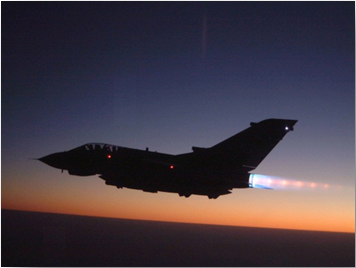RAF Tornado - IFD case studies

Until its retirement in early 2019 the Tornado had been the UK’s leading ground attack aircraft, constantly deployed on operations since the first Gulf War.
IFD™ testing was applied very successfully on Tornado GR4 aircraft systems in the 2 projects described on this page and in the video below. At the time of these projects the aircraft's offensive capability remained second to none, but the airframe was showing its age.
Nose-Wheel Steering Wiring
The nose-wheel steering system is susceptible to intermittent faults that are difficult to diagnose during flight line maintenance, which often leads to speculative replacement of other components. The project successfully demonstrated the ability of IFD testing (using an Ncompass-4000, since superseded by the VIFD) to detect hard and intermittent faults that conventional equipment were unable to detect. Unserviceable harnesses were confirmed to have intermittency and continuity faults; brand-new harnesses were confirmed as being both intermittency-free and continuity fault-free; and life-expired harnesses were found with intermittent faults even though they passed continuity testing.
Secondary Power System: the 5-year intermittent fault
 In another example, one specific Tornado aircraft had suffered an intermittent fault within the secondary power system for over 5 years and so Copernicus Technology was requested to assist. The IFD testing conducted by Copernicus Technology vastly accelerated the timeframe for isolating the fault, hence a ‘No Fault Found ‘ which had persisted for years was ultimately resolved in a matter of days.
In another example, one specific Tornado aircraft had suffered an intermittent fault within the secondary power system for over 5 years and so Copernicus Technology was requested to assist. The IFD testing conducted by Copernicus Technology vastly accelerated the timeframe for isolating the fault, hence a ‘No Fault Found ‘ which had persisted for years was ultimately resolved in a matter of days.
An analysis of the fault-maintenance history was conducted, along with an intermittent fault diagnosis of the system. As most of the system LRUs had already been replaced it was agreed that the condition of the wiring should be tested. The system’s wiring integrity was IFD-tested which pinpointed intermittency/noise/continuity issues in several of the system cables.
These cables were repaired by the RAF and then Copernicus Technology Ltd re-tested the system wiring, which confirmed that the system’s wiring integrity had been fully restored. Once the aircraft was rebuilt for flight testing it transpired that the intermittent fault’s symptoms were unchanged, enabling the RAF to now rule out both the LRUs and the wiring from the diagnosis. An external influence was suspected and this was traced to a faulty circuit-breaker (CB), which had been outside the scope of the original testing. The CB was IFD-tested which immediately confirmed that it was highly intermittent - once it had been replaced the fault did not recur. See the video below of IFD testing the CB, illustrating the ease of intermittent fault detection coupled with the immediate visual results feedback.
https://www.youtube.com/watch?v=5xCwEbxtBV4
If this case study sound similar to problems you're trying to solve then contact us now to discover how our products & services will help you: scroll down for our contact details
